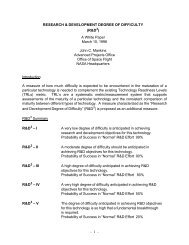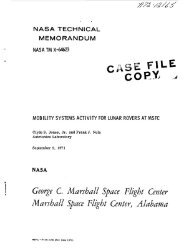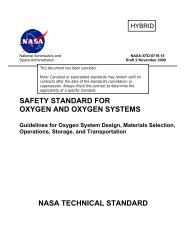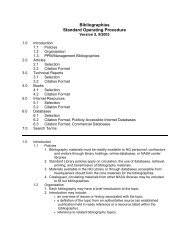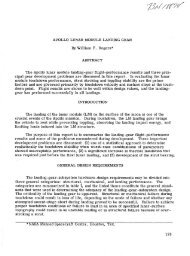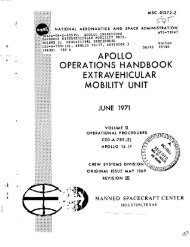crimping, interconnecting cables, harnesses, and wiring - NASA
crimping, interconnecting cables, harnesses, and wiring - NASA
crimping, interconnecting cables, harnesses, and wiring - NASA
You also want an ePaper? Increase the reach of your titles
YUMPU automatically turns print PDFs into web optimized ePapers that Google loves.
Page 110 of 114<br />
<strong>NASA</strong>-STD-8739.4 with Change 6<br />
APPENDIX B CRITICAL PROBLEMS IN COAXIAL CABLE<br />
ASSEMBLY<br />
Because of poor connector design, faulty assembly instructions, or wrong choice of materials,<br />
certain types of coaxial cable assembly failures occur frequently. Problem areas are as follows:<br />
a. Plastic Jacket Layer in the Compression System. Certain manufacturers' RF-connector<br />
designs or assembly instructions allow the jacket to be in the clamping system. For example, the<br />
metal clamp nut presses against the teflon cable jacket, which presses against the metal braid,<br />
which presses against the metal cable barrel of the connector. The problem encountered with<br />
this arrangement is that after torquing, the teflon jacket cold-flows, <strong>and</strong> the connection becomes<br />
loose. Intermittent circuits <strong>and</strong> system failure can result. Either this type of connector should<br />
not be used, or the plastic jacket should be trimmed back so that only metal-to-metal<br />
compression exists (see Figure B-1). If the connector design is such that satisfactory metal-tometal<br />
compression cannot be achieved after torquing, the connector should not be used.<br />
b. Inadequate Center Conductor to Center Contact Solder Joint. Certain manufacturers<br />
recommend that the center conductor be tinned, <strong>and</strong> that this tinned conductor be placed in the<br />
center contact. Then, the solder joint between the center conductor <strong>and</strong> center contact is made by<br />
reflowing the tinning in the center contact. Invariably, this makes an insufficient solder joint<br />
(see Figure B-2). A sufficient solder joint is made by placing a small length of rosin core solder<br />
in the contact wire well, e.g., 3.17mm (0.125 inch) length, 0.38 mm (0.015 inch) diameter. The<br />
center conductor is inserted into the wire well <strong>and</strong> the contact is heated to melt the solder <strong>and</strong><br />
position the contact on the center conductor.<br />
c. Breakage of Stress-Relief Sleeving. In assemblies where shrinkable sleeving is used to<br />
provide stress relief from a connector ferrule to the cable, there is often a major transition in<br />
diameter as shown in Figure B-3. If MIL-I-23053/8 sleeving is used for stress relief, it often<br />
cracks at the large diameter of the transition. The use of MIL-I-23053/8 sleeving for these<br />
applications should be avoided.






